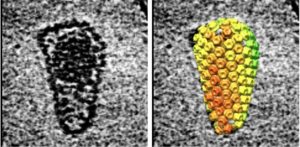Scientists have finally recreated in a test tube the first moments of infection with the human immunodeficiency virus (HIV). The infection occurs deep in the cells. That is why it has been extremely difficult to understand more about these initial processes so far.
Over the past century, HIV has caused a terrible pandemic – 33 million people have died worldwide. Today, 38 million people live with the virus. This new study, published in Science, provides an unprecedented view of infection and will allow us to learn more about the ways HIV works.
“We are learning new things about one of the most significant pathogens that humans have ever encountered. And that’s important, “said study co-authors Dr. Devin Christiansen and Dr. Barbie Ganser-Pornilos of the University of Utah.
Research shows that the role of the capsid (the outer shell of the virus) is much more complex than previously thought. Thanks to advances in electron microscopy, the team was able to visualize the 240 proteins that make up the outer shell.

Cryo-electron microscopy (left) and molecular modulation (right) of the HIW virus. At 130 nanometers, HIV is about 60 times smaller than erythrocytes. Source: Owen Pornillos, Barbie Ganser-Pornillos.
Scientists have previously suggested that the capsid simply protects the genetic material beneath it. However, the new study suggests that it is much more than an external shield and even directly helps infectious processes. The researchers found that the capsid remained largely intact during the replication process, known as reverse transcriptase. When the team uses genetic and biochemical methods to destabilize the capsid, the virus can no longer replicate effectively.
“Textbooks say very different things,” said senior researcher Wesley Sandquist. “Our data show that the viral capsid has an active and indispensable role in maintaining effective reverse transcriptase.”
HIV has been shown to cause acquired immune deficiency syndrome (AIDS) more than 35 years ago. Thanks to the tireless work of activists and scientists, anti-retroviral treatment today guarantees a normal and long life for people living with the virus. People undergoing effective treatment can reduce the virus to almost undetectable levels – to such an extent that they are virtually unable to pass it on to others.
Although scientific progress in this regard is impressive, people with HIV continue to be stigmatized and discriminated against.
Source: IFLScience











